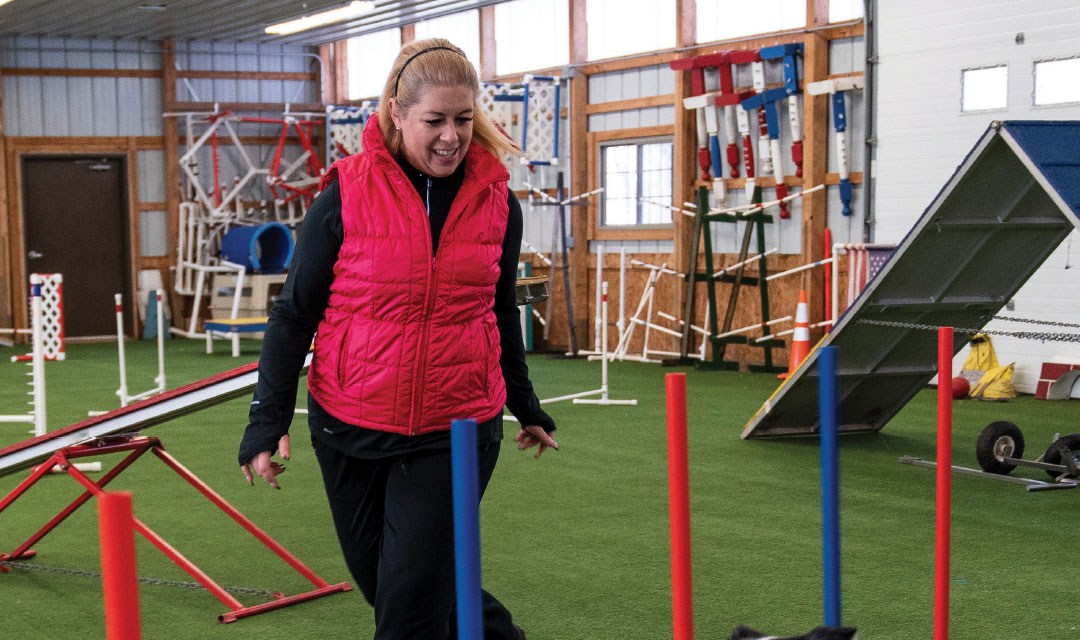“I feel great; I can exercise again. It’s been just amazing how swiftly I’ve been able to regain my strength.”

Whether riding on horseback or running alongside dogs in agility training, Sybil Carroll’s free time has happily revolved around animals for much of her life. But bleeding and discomfort from uterine fibroids made vigorous movement all but impossible and sidelined the 49-year-old South River woman from these passions several years ago.

Carroll, a communications administrator for Rutgers University Foundation, had dealt with her symptoms since her teens but says doctors didn’t always take them seriously. Robert Wood Johnson University Hospital (RWJUH) gynecologist Lena Merjanian, MD, was more helpful. About a decade ago, she diagnosed Carroll with uterine fibroids—noncancerous growths that develop from the muscle tissue of the uterus. Fibroids are silent in some women but in others can cause symptoms like heavy menstrual bleeding and pain. Dr. Merjanian monitored Carroll’s multiple fibroids with periodic ultrasounds, but they continued to get worse.
By age 47, Carroll was bleeding even between menstrual periods. “I would always hope my periods would start on a weekend,” she says. “I would miss work or couldn’t leave the house. I was in so much pain.”
Exploring Solutions
Medications and other noninvasive approaches weren’t stopping Carroll’s fibroids from growing. It was time for another approach, and she was referred to RWJUH obstetrician/gynecologist Adrian Balica, MD, who specializes in minimally invasive and other forms of gynecologic surgery, including for fibroids.
After first trying a minimally invasive uterine artery embolization to block the fibroids’ blood supply, Dr. Balica determined the situation called for a permanent solution: a robotic hysterectomy that would remove the uterus. Carroll was nearing menopause, but waiting for fibroids—growths that are fueled in part by reproductive hormones—to resolve naturally wasn’t an option. “We expected at minimum a few more years of this problem for her,” Dr. Balica says. “Although these surgeries are not emergencies, treating bleeding, growing fibroids and heavy pain is not elective.”
Hundreds of surgical procedures are performed robotically at RWJUH each year in a variety of specialties, including gynecologic, urologic, thoracic and ear, nose and throat surgeries. In recent years, robotic technology has been developed to facilitate robotic hysterectomy, which Dr. Balica considered an ideal choice for Carroll.
Requiring only a few tiny incisions instead of a lengthy cut typically done in traditional, open surgery, robotic surgery generally entails less blood loss and pain as well as quicker recovery. “The surgeon performs the surgery, but the robotic platform helps us do it,” Dr. Balica says.
Newfound Freedom
In August 2021, Dr. Balica used tiny surgical instruments that mimic human hand movements to remove Carroll’s uterus and fallopian tubes in a procedure lasting less than two hours, leaving her ovaries in place. Robotic equipment allows greater visualization of internal tissues with features such as binocular 3D imagery to view small structures. As a result of these capabilities, Dr. Balica was also able to see and cut out pieces of uterine lining that had migrated outside Carroll’s uterus into her pelvis, a painful condition known as endometriosis.
“Up to 15 percent of premenopausal women will also end up with endometriosis,” Dr. Balica says. “Being able to see so well with the equipment confirmed that this was true for Sybil.”
Carroll, whose mother and grandmother had both undergone open hysterectomy surgeries with long recoveries, was stunned at how quickly she bounced back from her robotic procedure. She was on her feet within hours and able to go home to her partner, Joe, and border collie, Switch, the same day.
“I’d had pain and cramps nearly my whole life, so this was nothing,” Carroll recalls. “I don’t want to downplay the time you need to let your body heal, but within days I felt great—better than I had in a long time.”
Her newfound freedom from constant bleeding and pain has Carroll hankering to get back on a horse. “I can’t wait to get in the saddle,” she says. “I feel great; I can exercise again. It’s been just amazing how swiftly I’ve been able to regain my strength.”
She’s also free from constantly preparing for potential consequences of pain and bleeding. “I won’t have to go to work bringing another set of clothes, just in case,” she says. “I get to travel without packing a whole other suitcase. I feel good both mentally and physically.”
Learn more about robotic surgical services at RWJUH.